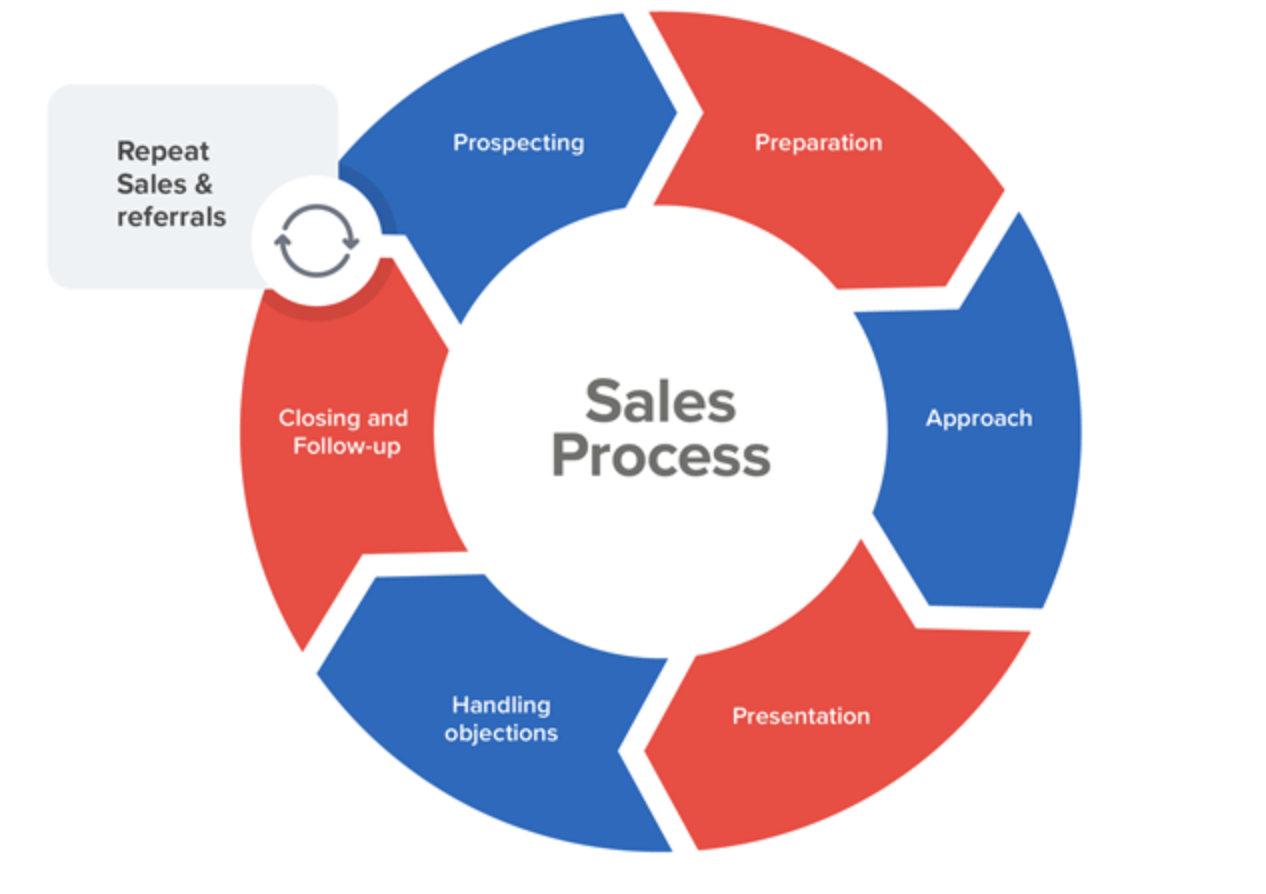Today, sales are a lot more than just asking “Can I help you?” with a fixed smile — especially in the B2B sector. So, in this article, we’ll cover the key steps to a successful sales process and what you should do during each of them.
What You Need to Know about the Sales Process
What is the sales process? Most companies today follow these seven steps involved in the sales process consecutively: Prospecting
- Preparation
- Approach
- Presentation
- Handling Objections
- Closing
- Follow-Up
Life doesn’t always go as planned. We need to react to new circumstances and adapt to them. In such situations, this scheme will help you improvise in the most efficient way.
Imagine you are working in a home appliances store and you are trying to sell your client a steam cooker. The client is asking you to be as fast as possible because he needs to be at his younger daughter’s wedding in an hour. Do you think he wants to hear the product presentation? Obviously, he doesn’t. So, you just process the order, give him the receipt, and wish him well.
Why is this important? As you have already understood, you will not get far in sales without improvising.
To make the sales process clearer for yourself, take a look at the image depicting the key steps below:

And now, let’s cover all the peculiarities of the sales process steps with examples.
7 Sales Process Steps: Your Ultimate Guide
Let’s take a closer at the 7-step sales process: Prospecting, Preparation, Approach, Presentation, Handling Objections, Closing, and Follow-Up.
Prospecting
The most common mistake many salesmen make is that they start with telling the client about all the advantages of the product or service. They think they don’t have anything else to talk about with their clients except for that. Therefore, they fuss, babble and do basically anything to avoid awkward silence and make sure the client doesn’t consider them incompetent or useless.
However, as you may have already understood, this is not the best strategy. The first thing a perfect salesperson must do is pinpoint the client’s needs (i.e., their pain points). So, the salesperson just asks leading questions and listens to the client’s answers. Consequently, the more information you get from the client during such a conversation, the more likely you are to close the deal.
During this step, the salesperson should be an active listener (which means responding to what the client says verbally and non-verbally). What is important, you should avoid asking too many questions – up to 20 questions in total will do fine.
Preparation
Now that you have all the information the client gave you before, you will know how to present your product for this particular person in the most enticing way. Perhaps, you will need to come up with a legend like this one: “Company X encountered similar issues, then they reached out to us, and we solved them at the fundamental level”. The most important part is selecting the arguments that will make your story easy to believe and fall for.
Approach
There is a rule of three “+” during contact establishment. In order to make a stranger like you, you should evoke positive emotions in him or her at least three times. Salesmen usually achieve this by using non-verbal signs (smiling to the clients and adopting open body language), giving compliments (although it shouldn’t turn into obvious flattery), and asking questions that guarantee positive answers. Salesperson’s likable appearance, confident voice, and sincere (or at least seeming to be so) desire to help the client are also the keys to establishing the contact.
Presentation
During this stage, you just “press” the pain point that is the most crucial for the client. He or she will be ready to spend some money and make a deal with you only to get rid of a truly disturbing pain point. (You already know what it is because the client already told you about it during the prospecting stage.)
As for the presentation itself, don’t limit yourself to an aesthetically pleasing PowerPoint one (although it can be a good idea in some cases). In general, the presentation is any convenient place where you can show the best of your product. This is why many deals are closed in an informal setting (for example, in a restaurant).
The key point of the presentation is for you to connect the characteristics of your product or service with the concrete benefits for the client. Use 5-7 such phrases in the presentation. But remember – if you exceed this number, your speech will be perceived as too intrusive.
Handling Objections
During this stage, the salesperson’s task is to address the client’s objections by diminishing all the ‘but’s and ‘no’s to their minimum.
Perhaps, you will encounter a situation where your client starts arguing. It happens, and it is a usual thing. If you are negotiating a serious deal or you are talking to a difficult client, you should brace yourself for five or six ‘no’s before you finally close the deal.
The main technique for dealing with this is replying by agreeing. It doesn’t matter what the client tells you; you have to agree with him or her every time. It is important to understand that you should agree not with your product/service being low-quality but with the opinion having the right to exist. So, basically, you communicate to the person: “Yes, you have the right to think so”.
Imagine your client telling you: “Your steam cookers are low-quality”. In this case, you should start answering in such a manner: “I agree with you that considering the quality when choosing home appliances is very important, …” Then, you continue with the advantage of your product.
In other words, you shouldn’t use arguments like “you are not smart enough to appreciate the quality of our steam cookers” to deal with an objection. Instead, you should try to softly lead the client to the main benefits of your product or service that you have demonstrated during the presentation (and remember – they are related to the client’s pain points).
Closing
During the closing stage, you should nudge the client in the direction of making a purchase. There are several easy techniques that will help you do this.
For example, you can say: “So, we have taken a look at this and that. Tell me, what did you like the most?” (and you just wait for the client to answer). Usually, the client will say something like “I liked that your steamer has three tiers”. Then you ask: “And what do you think about our product/service as a whole?” (and you wait for the client’s response again).
In this case, the client will convince himself or herself that if they like a certain thing about your product, they like the whole product itself. And this is what you will hear as a result.
The next thing you should ask is “Do you have any questions left?” and wait again. If there are some, you answer them; if not, you say: “I am very glad you liked everything. So, the only thing left to discuss is…” and you start negotiating the documents, delivery, etc. – and this will lead the client straight to making the purchase.
Follow-Up
During this stage, you seal the deal fast and with no mistakes to form a good final impression about you and your presentation in general. Your aim is to make the client leave with the feeling of a successful deal instead of the feeling of being cheated or pressured into buying something.
How to Design the Sales Process for Your Company
Obviously, the sales process will differ for every company one way or another. Some companies sell their products right in the store, some companies seal the deal in luxurious restaurants. Therefore, while following the recommendations described above, keep in mind that you need to adapt them to your particular situation.
For instance, if you sell an extremely expensive product or service, the presentation shouldn’t be expressed just with words – prepare a document with infographics, statistics, and other convincing facts. Or, in case you sell steam cookers, such an approach would look funny at best. Instead, what you need to do is show the client how your steam cooker works in real time or at least in a video.

5 Tips on Designing the Sales Process
In order to develop your own sales process scheme that will be tailored to the specifics of your business, follow these five tips:
- Do your research on the clients before you meet with them for the first time. This will help you make all the seven steps in sales process smooth, with as few objections as possible;
- Create scenarios for talking to different clients. Usually, all the company’s clients can be categorized into several groups – the so-called client personas. Each client persona has their own pain points, and your every scenario should contain an offer for the client to get rid of them, thus benefiting the client;
- Optimize your strategy. Consider removing certain steps of the sales process – perhaps, it will be beneficial in your case. This is how you can make the result of your actions more predictable;
- Test it. Think about where and how you can test your strategy without any potential damage to your business. If you choose to implement it right away, you may encounter obstacles you can’t overcome, and the strategy may turn out to be unviable;
- Revisit it. Your potential clients’ needs may change with time, so you need to be as flexible as possible and adopt new approaches to win over your clients’ hearts. Therefore, keep analyzing the market tendencies instead of using the same strategy for years.
How to Automate Your Sales Process
Automation is one more key to making your sales successful. The easiest and fastest way to automate your sales is to implement a CRM system into your current business processes. In case you have a lot of clients, such a system will help you structure the huge daily influx of data that your salesmen have to deal with.
If you don’t serve thousands of clients per day but closing a deal takes days or even months (which is a usual case in B2B business relations), a CRM system will help you keep track of every detail that may turn out to be the decisive factor for the success of your efforts.
Your Checklist for Designing the Sales Process
To sum up everything we’ve covered above, let’s emphasize five crucial things you need to do before you start developing your own plan for the successful sales process:

- Determine the client’s pain points;
- Choose the most efficient format of the meeting with the client (with some space for the presentation);
- Consider creating “legends” for the clients – plausible stories about your other clients that benefit from using your product or service;
- Help the client make a purchase instead of trying to help your company sell;
Use software solutions for automating interaction with the clients (as we’ve mentioned above, put your sales process in the CRM).
How to Organize the Sales Process
You already know that in order to make your approach towards sales systematic, you should employ the help of a CRM system. Thanks to having all the client data and sales progress information in one place, you will see the bigger picture – i.e., you’ll know how successful sales are at the moment and what should be improved in future. We invite you to experience these benefits yourself by trying the demo version of Nimble. We can guarantee you will be amazed by its robust functionality, convenience, and intuitiveness.
Conclusion
The step-by-step sales process can help not only inexperienced managers but also those who have been working in this field for years. By implementing it, you will know how to react in a difficult situation while automating all the steps involved in an effective sales process to boost your productivity. In their turn, such software solutions as CRM systems will definitely help you make your sales process as efficient as possible.



